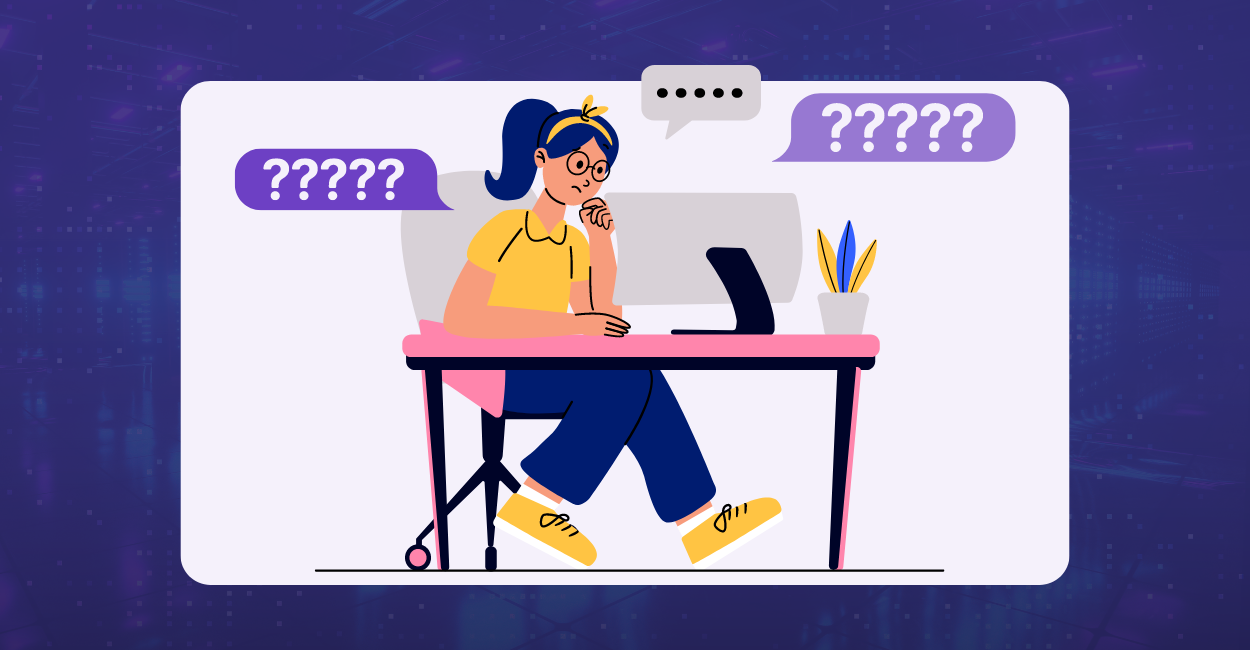Hey, AI Writing Enthusiasts!
Recently, we rolled out one of our most useful AI writing features yet: evyAI Templates!
Since it went live, we’ve received many questions about how Templates can help you streamline your professional networking activity and help your growth.
That’s why we’ve compiled this super in-depth breakdown of the kind of Templates you can use, with lots of applicable examples!
You can store your AI writing templates in evyAI.com and use them via the desktop web app, the side panel Google Chrome extension and—now—via the mobile web app as well. That means you can pull up your templates on the go!
Here are the 5 different types of AI writing templates you need to use in your business to generate leads and support your workflow:
AI Writing Template Types:
Let’s go into each type to help you get the most out of your online experience and reduce the time you spend networking with the power of AI writing.
1. Comment Templates
Here are the most common templates you can use for commenting on social media. This will help you leave a thoughtful comment instead of a generic “GREAT POST”.
You don’t want to leave comments that are less than 7 words because comments that are longer than 7 words get shown on the feed and give you and the author of the post even more exposure.
Example comments:
There are 10 example comments for different types of social media posts:
- Agreeing with a Post: “Absolutely agree with your points here, very insightful!”
- Expressing Gratitude: “Thank you for sharing this valuable information. Much appreciated!”
- Offering Congratulations: “Congratulations on your achievement! Well deserved and inspiring!”
- Engaging with a Thought-Provoking Post: “This really made me think differently about the topic. Great post!”
- Commenting on an Educational Post: “Learned a lot from this. Thanks for breaking it down so clearly!”
- Responding to a Motivational Quote: “Love this quote! A great reminder to stay positive and focused.”
- Acknowledging a Personal Story: “Thank you for sharing your journey. Your story is truly inspiring!”
- Showing Support for a Cause or Initiative: “Fantastic initiative! I’m excited to see the positive impact it will have.”
- Reacting to Industry News: “Interesting update! This will definitely shape the future of our industry.”
- Engaging with a Poll or Question: “Great question! My vote goes to option two for its practicality.”
These comments are tailored to different types of social media posts and are designed to be engaging and specific.
Remember to STORE these templates inside evyAI at app.evyai.com/templates or in the side panel Chrome extension.
When engaging on social media, the most effective comments are those that add value and foster meaningful interactions.
Here are the top 5 types of comments that people typically leave:
- Agreeing or Endorsing a Viewpoint:
Purpose: To express agreement and support the original post’s message.
Example: “Completely agree with your perspective on this issue. Well said!”
- Offering Congratulations or Celebratory Messages:
Purpose: To acknowledge achievements, milestones, or positive news shared by the poster.
Example: “Congratulations on the new role! Wishing you all the success in your next adventure.”
- Asking Questions or Seeking Clarification:
Purpose: To engage further with the content by seeking more information or a deeper understanding.
Example: “Great insights! Could you elaborate more on how this approach can be applied in small businesses?”
- Adding Personal Insights or Experiences:
Purpose: To contribute additional value by sharing relevant personal experiences or insights.
Example: “This has been my experience as well. In my last project, implementing this strategy really made a difference.”
- Providing Constructive Feedback or Different Perspectives:
Purpose: To offer a thoughtful critique or share a different viewpoint, promoting a balanced discussion.
Example: “Interesting take! I see it slightly differently. I believe there’s also a need to consider the impact on customer satisfaction.”
These types of comments are effective because they not only engage with the original content but also encourage further conversation and connection.
Here are five less popular but still useful types of comments to consider when engaging on social media:
- Tagging Others for Their Input:
Purpose: To bring a post to someone’s attention who might find it relevant or have valuable input to add.
Example: “This is a great discussion. @JaneDoe, I’d love to hear your thoughts on this!”
- Offering Help or Resources:
Purpose: To provide assistance, resources, or additional information that could benefit the poster or others reading the post.
Example: “This is a common challenge. Here’s a link to a resource that might help [insert link]. Happy to discuss more if needed!”
- Sharing Related Content or Links:
Purpose: To enhance the discussion by sharing relevant articles, studies, or tools that align with the topic of the post.
Example: “This reminded me of a recent article I read on this topic. Here’s the link: [insert link]. Worth checking out!”
- Acknowledging Effort or Creativity:
Purpose: To recognize the effort, creativity, or unique perspective someone put into their post.
Example: “Really appreciate the creativity you brought to this topic. It’s a fresh take that stands out!”
- Encouraging Further Discussion:
Purpose: To stimulate deeper conversation or invite others to share their views, often by posing follow-up questions.
Example: “Great points raised here! I’d love to know, what do others think about how this trend will evolve in the next few years?”
These comments are less common but can be very effective in building deeper connections and enriching discussions.
They show thoughtfulness, encourage engagement from a wider audience, and can provide additional value to the conversation.
Remember to create several comments for different situations that have your VOICE and that people won’t copy. All those comments can be customized for you based on your voice.
2. Direct Message Templates
When it comes to DMs, you need to have templates ready for different scenarios.
We teach the Greeting, Feeding, and Meeting method. And in each category inside our strategies we give many template options.
If you want to learn more about our Training you can visit evyrgreen.com.
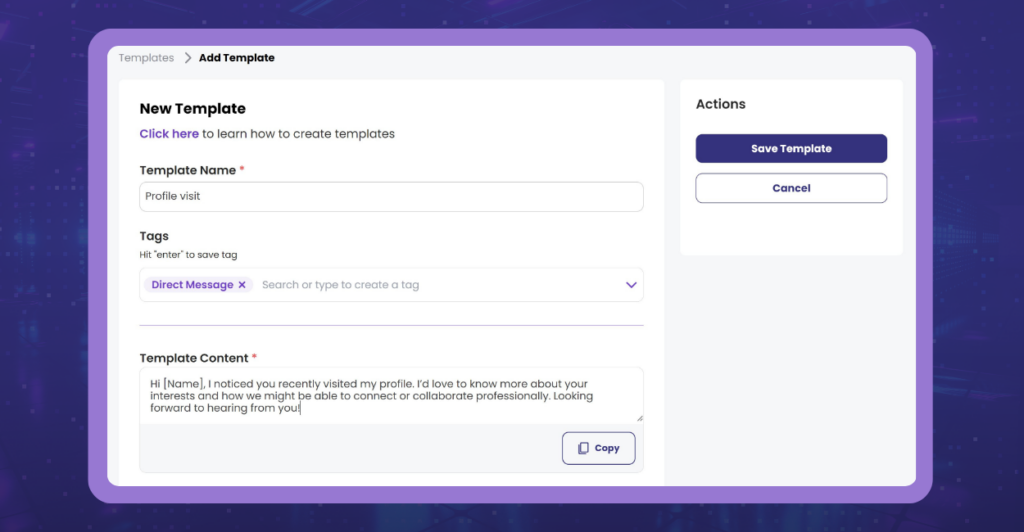
Here are 10 ideas for DM templates with two examples for each scenario: one professional and one conversational.
2.1. When Someone Visits Your Profile
Professional:
- Subject: Thank you for visiting my profile!
“Hi [Name], I noticed you recently visited my profile. I’d love to know more about your interests and how we might be able to connect or collaborate professionally. Looking forward to hearing from you!”
Conversational:
- Subject: Great to see your interest!
“Hey [Name], thanks for stopping by my profile! I see we share an interest in [common interest or field]. Would love to chat more about it sometime. Let’s connect!”
2.2. When It’s Someone’s Birthday
Professional:
- Subject: Happy Birthday, [Name]!
“Hi [Name], I hope you’re having a fantastic birthday! Wishing you a year filled with success and new opportunities. Let’s catch up soon!”
Conversational:
- Subject: Birthday Wishes
“Hey [Name], just wanted to wish you a very happy birthday! Hope you get to enjoy your special day and maybe do something fun to celebrate. Cheers!”
2.3. When Someone Has a Promotion at Work
Professional:
- Subject: Congratulations on Your Promotion!
“Hi [Name], congratulations on your promotion to [new position] at [company]! I’m sure you’ll bring a lot of value in your new role. If there’s ever a chance to collaborate, I’d love to explore that.”
Conversational:
- Subject: Way to Go!
“Hey [Name], huge congrats on your new role as [new position]! That’s fantastic news. Let’s grab a coffee sometime to celebrate and catch up!”
2.4. When Someone is Celebrating an Anniversary
Professional:
- Subject: Happy Work Anniversary!
“Hi [Name], congratulations on your [number] year anniversary at [company]! Your dedication and hard work are truly inspiring. Here’s to many more successful years ahead!”
Conversational:
- Subject: Congrats on Your Milestone!
“Hey [Name], happy anniversary with [company]! Time flies, doesn’t it? Hope you’re celebrating this milestone in a special way. Let’s connect soon and catch up.”
2.5. When You Are Impressed by Someone’s Content
Professional:
- Subject: Impressive Content, [Name]!
“Hi [Name], I recently read your post about [topic] and found it incredibly insightful. Your perspective on [specific point] was particularly enlightening. Would love to discuss it further sometime.”
Conversational:
- Subject: Loved Your Recent Post!
“Hey [Name], I just read your latest post and it really resonated with me. You have a knack for breaking down complex ideas into relatable insights. Keep up the great work!”
2.6. When DMing with Someone You Have Not Spoken to in a While
Professional:
- Subject: Let’s Reconnect, [Name]!
“Hi [Name], it’s been a while since we last spoke. I’d love to catch up and hear what’s new with you professionally. Let’s schedule a time to reconnect.”
Conversational:
- Subject: Long Time No See!
“Hey [Name], it’s been ages! I’d love to hear how things have been going for you. Let’s grab a virtual coffee soon and catch up on life and work.”
2.7. When Thanking a Connection for Connecting
Professional:
- Subject: Thank You for Connecting!
“Hi [Name], thanks for connecting with me. I’m looking forward to staying in touch and exploring ways we might be able to support each other’s professional journeys.”
Conversational:
- Subject: Great to Connect!
“Hey [Name], thanks for adding me to your network! Excited to keep in touch and see how we can collaborate or help each other out in the future.”
2.8. When Reaching Out to Someone You Never Spoke To
Professional:
- Subject: Introduction and Potential Collaboration
“Hi [Name], I came across your profile and was impressed by your work in [field/industry]. I’d love to connect and discuss any potential opportunities for collaboration or mutual support. Looking forward to your thoughts.”
Conversational:
- Subject: Great to Meet You!
“Hey [Name], I noticed we share some interests and mutual connections. I’d love to learn more about what you do and see if there are ways we can connect or collaborate. Let’s chat!”
2.9. When Asking Someone to Vote on a Poll
Professional:
- Subject: Your Opinion Matters!
“Hi [Name], I’m running a poll on [topic] and would value your input. Could you take a moment to share your thoughts? Here’s the link: [insert link]. Thank you!”
Conversational:
- Subject: Quick Favor: Vote on My Poll?
“Hey [Name], I’ve got a quick poll on [topic] and I’d love your vote. It’s a short one, here’s the link: [insert link]. Appreciate your help!”
2.10. When Requesting for Someone to Engage with Your Recent Post
Professional:
- Subject: Your Feedback on My Latest Post
“Hi [Name], I recently posted about [topic] and would greatly value your thoughts and feedback. Here’s the link: [insert link]. Looking forward to your perspective!”
Conversational:
- Subject: Check Out My Latest Post?
“Hey [Name], I just shared a new post on [topic] and thought you might find it interesting. Would love to hear your thoughts! Here’s the link: [insert link]. Thanks!”
These templates provide a mix of professional and conversational tones suitable for different social media engagement scenarios.
You can modify the DM Templates above to make them more generic, without name or topic customization.
3. Connection Note Templates To Use for Connection Requests
The side panel’s AI writer will create your connection note for you but it’s helpful to give it context with a template so it knows how to make it just right for you.
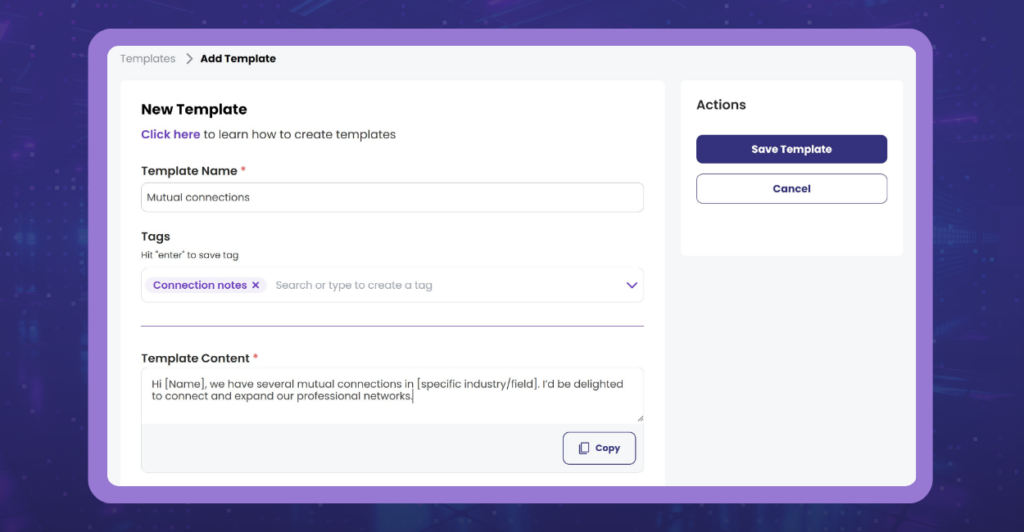
When sending connection notes, it’s important to personalize your message to make a meaningful connection.
Here are 10 scenarios with suggested types of notes to include:
3.1. Shared Professional Interests:
- Note: “Hi [Name], I noticed we both share a strong interest in [specific industry/field]. I’d love to connect and discuss how we might collaborate or share insights in [industry/field].”
3.2. Mutual Connections:
- Note: “Hi [Name], we have several mutual connections in [specific industry/field]. I’d be delighted to connect and expand our professional networks.”
3.3. Attended the Same Event:
- Note: “Hi [Name], I saw you attended [Event Name]. I enjoyed [specific aspect of the event] and thought it would be great to connect and discuss our takeaways.”
3.4. Alumni Connection:
- Note: “Hi [Name], as a fellow [University/School Name] alum, I’d love to connect and hear about your experiences since graduation. It’s always great to connect with fellow [mascot/nickname]!”
3.5. Read Their Content:
- Note: “Hi [Name], I recently read your article on [topic] and found it very insightful. I’d like to connect to keep up with your future posts and perhaps discuss [related topic].”
3.6. Common Group Membership:
- Note: “Hi [Name], I noticed we’re both members of the [Group Name]. Your contributions to the group have been very informative. I’d love to connect and share more ideas.”
3.7. Compliment Their Work:
- Note: “Hi [Name], I’ve been following your work at [Company Name], and I’m impressed by [specific project or achievement]. I’d like to connect and learn more about your approach.”
3.8. Industry Expertise:
- Note: “Hi [Name], I see you have extensive expertise in [specific field]. I’m currently exploring more about [related topic] and thought connecting with you could be very insightful.”
3.9. Career Transition:
- Note: “Hi [Name], I noticed you recently transitioned to [new role/new industry]. As someone who’s also interested in [related field], I’d love to connect and hear about your journey.”
3.10. Potential Collaboration:
- Note: “Hi [Name], I’m working on [specific project/initiative] that aligns with your expertise in [field/industry]. I’d love to connect and explore possible collaboration opportunities.”
Bonus Tips for Writing Effective Connection Notes:
- Personalize: Use their name and reference specific details about their work or background.
- Be Concise: Keep your message brief and to the point.
- Offer Value: Highlight why connecting could be mutually beneficial.
- Avoid Sales Pitches: Focus on building a genuine connection rather than immediately pushing a product or service.
4. Snippets for Social Media Posts To Save As Templates
When it comes to posting, it’s helpful to include snippets as a template so you can add those elements to your posts.
Creating effective snippets for social media posts can help you engage your audience and make your content more impactful.
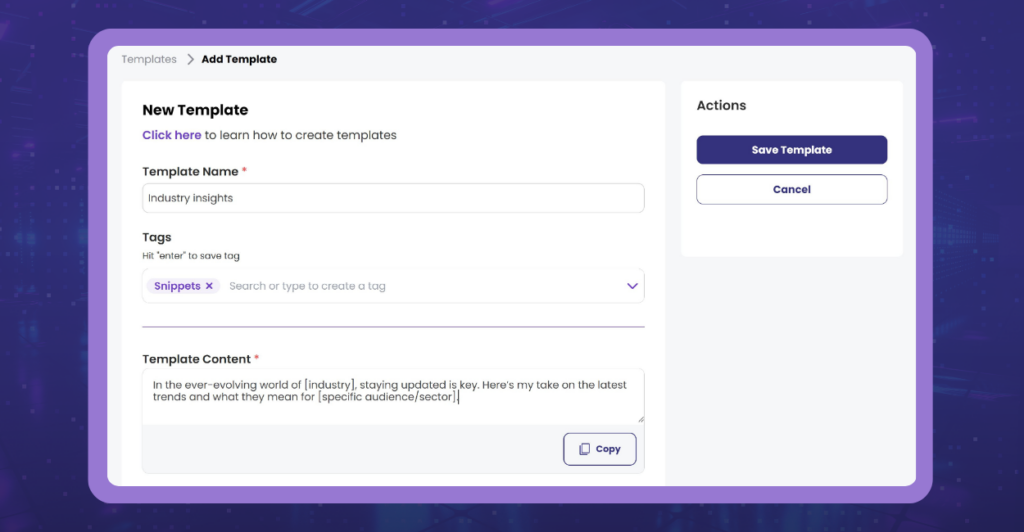
Here are some recommended snippets to have ready as templates for various types of posts:
4.1. Industry Insights:
- Snippet: “In the ever-evolving world of [industry], staying updated is key. Here’s my take on the latest trends and what they mean for [specific audience/sector].”
4.2. Professional Achievements:
- Snippet: “Excited to share that [achievement or milestone] has been reached! It’s a significant step towards [goal/mission]. Grateful for the support and teamwork that made this possible.”
4.3. Thought Leadership:
- Snippet: “In my recent exploration of [topic], I’ve uncovered some interesting perspectives. Here’s why I believe [specific idea or insight] will shape the future of [industry/field].”
4.4. Event Announcements:
- Snippet: “Thrilled to be part of [event name]! Join me on [date] to discuss [topic]. Looking forward to connecting with [target audience/industry professionals].”
4.5. Client Testimonials:
- Snippet: “Humbled by this feedback from [Client Name/Company]. Their words truly highlight our commitment to [service or product quality]. Here’s what they had to say: [testimonial quote].”
4.6. Team Celebrations:
- Snippet: “Celebrating the incredible efforts of our team at [Company Name]! Their dedication to [specific project or initiative] has led to [positive outcome]. Proud to work alongside such talented individuals.”
4.7. Product or Service Launch:
- Snippet: “Introducing [Product/Service Name], designed to [solve a specific problem or enhance a particular aspect]. Discover how it can [benefit or impact] for [target audience].”
4.8. Call to Action:
- Snippet: “Looking to [achieve a specific goal]? Here’s how [Company Name/Product] can help you [specific benefit or solution]. Let’s connect and explore the possibilities!”
4.9. Educational Content:
- Snippet: “Learning never stops! Dive into my latest guide on [topic], where I break down [key aspects or steps]. Perfect for anyone looking to [achieve a specific outcome].”
4.10. Personal Reflections:
- Snippet: “Taking a moment to reflect on [personal experience or journey]. It’s been a path filled with [challenges/lessons], and I’m grateful for [support or key learning]. What’s been your biggest learning this year?”
4.11. Motivational Quotes:
- Snippet: “[Inspirational quote related to the post’s content].” These words resonate deeply with me, especially when it comes to [specific professional or personal challenge]. What inspires you to keep pushing forward?”
4.12. Networking Invitations:
- Snippet: “Excited to expand my network with professionals passionate about [industry or topic]. If you’re keen on [specific interest or field], let’s connect and share insights!”
4.13. Polls and Engagement:
- Snippet: “Curious about what others think regarding [specific topic]. Cast your vote in my latest poll and share your thoughts. Let’s spark a conversation on [related issue or trend].”
4.14. Resource Sharing:
- Snippet: “Just came across this fantastic resource on [topic]. It’s packed with valuable insights and tips on [specific subject]. A must-read for anyone in [industry or role].”
4.15. Company Updates:
- Snippet: “Exciting times at [Company Name]! We’re gearing up for [upcoming project/event]. Here’s a sneak peek into what’s coming and how it’s set to make a difference in [industry or community].”
Tips for Effective Snippets:
- Stay Relevant: Align your snippet with the content of your post.
- Be Engaging: Use language that invites interaction and engagement.
- Add Value: Ensure your snippet offers a clear benefit or insight to your audience.
- Keep It Brief: Snippets should be concise and to the point, ideally just a few sentences.
These templates can be customized and adapted to suit the specific content and tone of your social media posts.
Using snippets can be really helpful for posts. You can also save some hooks as templates as well.
5. Hooks for Social Media Posts to Save as Templates
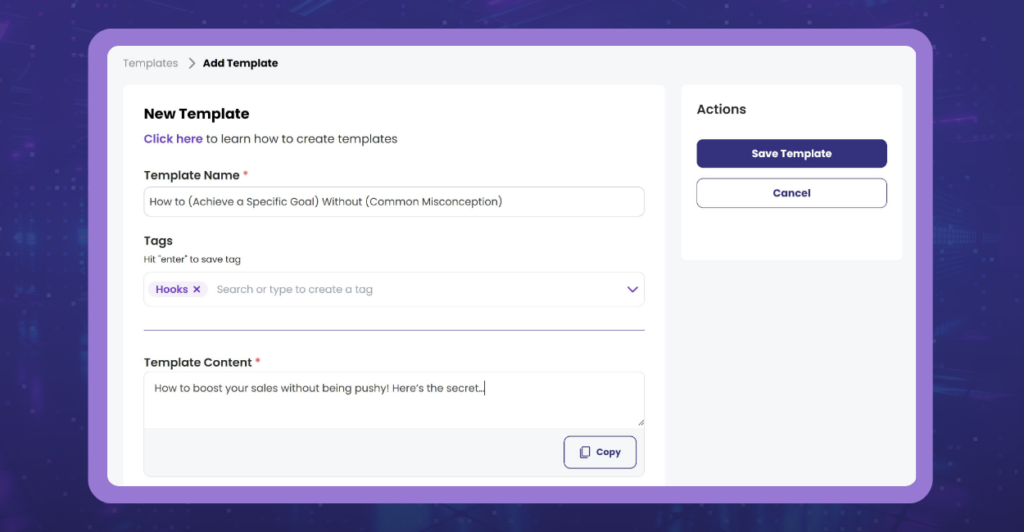
5.1. How to (Achieve a Specific Goal) Without (Common Misconception):
- “How to boost your sales without being pushy! Here’s the secret…”
5.2. The Truth About (Industry Practice/Concept) That No One Talks About:
- “The truth about remote work that no one talks about – it’s not just lazy work.”
5.3. The Biggest Mistake (Professionals/Audience) Make in (Specific Activity):
- “The biggest mistake job seekers make in interviews and how to avoid it.”
5.4. What I Wish I Knew About (Topic) Before I (Action/Decision):
- “What I wish I knew about investing before I started my business.”
5.5. Stop Doing (Ineffective Practice) and Start Doing (Effective Alternative):
- “Stop multitasking and start focusing on one task at a time for better productivity.”
5.6. Here’s What (Successful People/Experts) Do Differently in (Activity/Field):
- “Here’s what successful entrepreneurs do differently in networking.”
5.7. Why (Common Belief) Is Actually Holding You Back in (Field/Activity):
- “Why believing you need a perfect resume is actually holding you back in your job search.”
5.8. A Surprising Fact About (Topic) That Will Change How You (View/Do Something):
- “A surprising fact about time management that will change how you plan your day.”
5.9. (Number) Things You Didn’t Know About (Topic/Field) That Could Transform (Outcome):
- “5 things you didn’t know about marketing that could transform your lead generation.”
5.10. Why You Should (Action) If You Want to (Achieve a Specific Result):
- “Why you should build a personal brand if you want to advance your career.”
Bonus: Examples Tailored to Specific Professions and Topics
- For Real Estate Agents: “This is what a great Real Estate Agent will do for you! It’s more than just showing houses.”
- For Financial Advice: “Here’s a saving secret that you need to know to maximize your earnings.”
- For Fitness Enthusiasts: “Stop overcomplicating fitness! Simple routines can yield amazing results.”
- For Entrepreneurs: “CEOs all over the world are losing their minds over this new business trend!”
- For Personal Development: “I’m gonna teach you how to get smarter in a way that even a 5-year-old can understand.”
These hooks can be adapted to suit your specific content, ensuring your posts grab attention and engage your audience effectively.
Remember to include Call to Action and links to your templates!
Templates will save you a TON OF TIME if you use them well, so go ahead and copy the ones that resonate the most with you and create your own library of templates inside evyAI.com.
If you want to see more template examples and get more tips like these, join our Skool community!
BOOM!
Try out evyAI for FREE by installing the Chrome extension here.
If you like evyAI consider upgrading to premium at evyai.com/upgrade.

